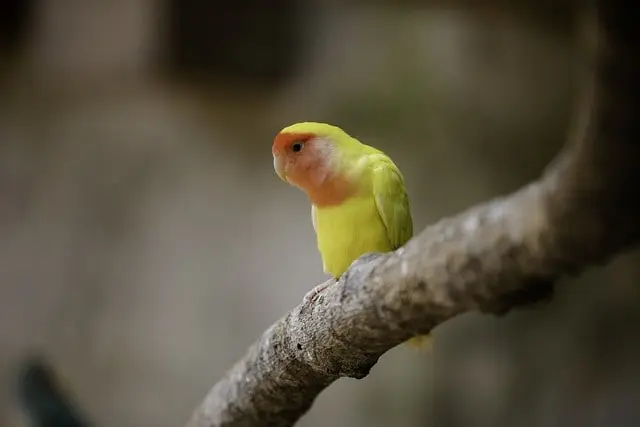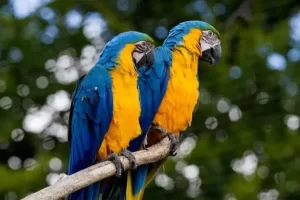Parrots come in a variety of shades of yellow, from citrine to rich golden, amber, and sunshine glow. However, most parrots do not sport a full yellow plumage but rather have other colors mixed in.
The color yellow in parrots is produced by pigments called psittacofulvins, which are also responsible for red and orange hues. Even though yellow is locally produced by parrots, this color is not all that common in the parrot kingdom. Some scientists believe that bright colors may be a disadvantage in avoiding predators.
However, warm yellow colors have one advantage for parrots. According to Biology Letters, yellow feathers fluoresce under ultraviolet light, which plays a role in mate selection in parrots. Other feather colors such as red do not glow under ultraviolet light.
Quick Navigation
Types Of Yellow Parrots
Here are 11 parrot species that are yellow:
Sun Conure
Sun conures sport the iconic summery yellow coloring with shades of orange on different parts of their body, notably on their cheeks and abdomen. They also have green and blue on their wings and tails.
In the wild sun conures feature the traditional yellow plumage, but captive breeding has given rise to different mutations which has varying amounts of yellow.
The sun conure has a striking yellow plumage and an equally fiery personality to match that. They are very playful and energetic birds that need plenty of out-of-cage time and interaction from their owners. If they don’t get adequate socialization, they may develop behavioral problems.
Sun conures are famous for their notoriously loud calls that can reach decibel levels harmful to long-term hearing. These birds are not for apartment living or for people who cannot handle loud noises.
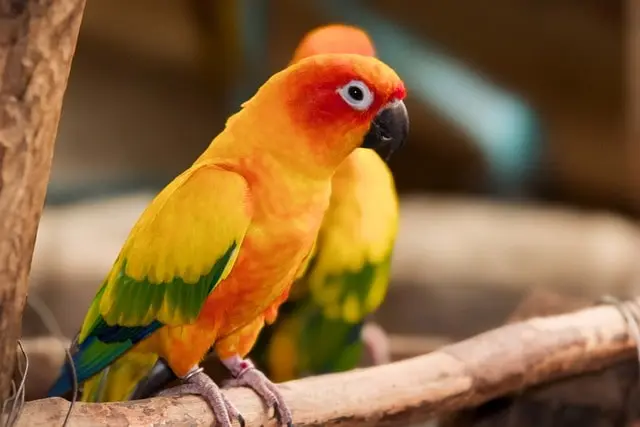
Golden Conures
The Golden Conure also known as the Queen of Bavaria Conure, is a small parrot endemic to the Brazilian Amazon forest. Golden conures have bright yellow plumage and dark green outer upper wings.
They are prized for their attractiveness and as such, these conures have undergone a substantial population decline over the past two decades due to the illegal pet trade. In addition to that, they also face threat from habitat loss due to deforestation.
Currently, their species is classified as threatened and its population numbers are declining. They are also quite rare in captivity. Golden conures are inquisitive and intelligent as pets and need lots of attention. They also have the proclivity to make loud calls and vocalizations frequently.
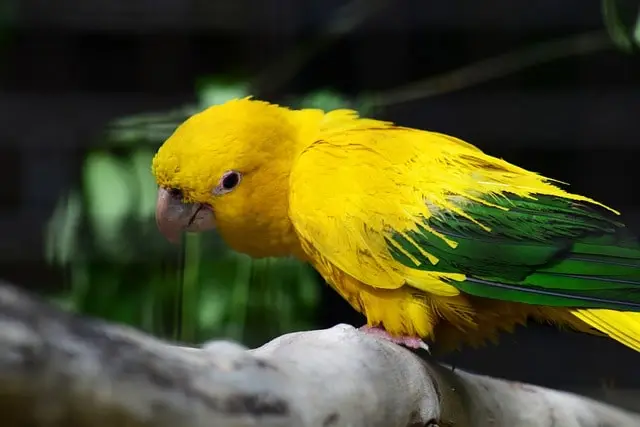
Jenday Conure
The Jenday Conure, also known as the Jandaya Parakeet, is a small parrot native to northeastern Brazil. Jenday Conures exhibit a uniform yellow coloration on their head and neck transitioning to an orange shade on the breast, abdomen, and underwing coverts. The wings and tail are green with slight blue on the edges.
These conures are playful and feisty, which means they require tons of time with their owners and out of the cage. Since they are highly active, a roomy cage is appropriate for them to freely zip around.
They are extremely loud though, making screeching noises that can make ears ring if held too close. They also have a reputation for being nippy initially, but once the bond is made, they can be very affectionate.
Blue And Gold Macaw
Blue-and-gold macaws are primarily blue and yellow. They have blue feathers covering their neck, wings, and the top of the tails. While their chest, abdomen, and underwings are yellow.
They are a popular macaw species admired for their beautiful colors and charismatic personalities. Being large parrots, they require an outdoor enclosure where they have access to sunlight and enough space for enrichment.
They are incredibly intelligent and great talkers capable of learning a large set of words and phrases. Blue and gold macaws are a fun pet to have in the family, though their care and socialization demands a great degree of commitment.
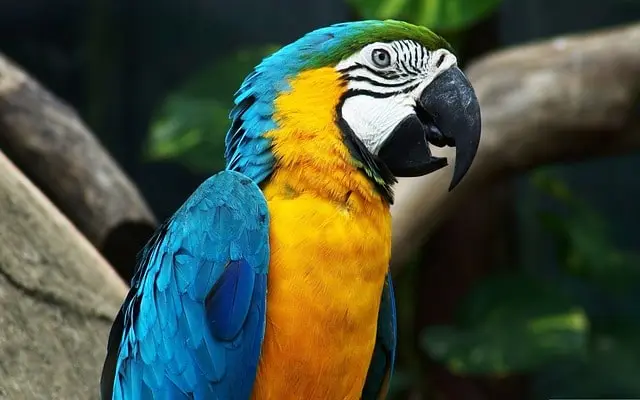
Budgerigar (Yellow Mutation)
Budgerigars are small parakeets that occur predominantly in green and yellow colors in the wild. However, captive breeding of these birds has produced nearly all the colors.
The yellow mutation of the budgerigar is quite common in captivity and has an alluring sunny yellow plumage with white cheeks.
Budgies are a good choice for novice bird owners as they are easily tamed and adapt well to small apartments.
They chirp and chatter frequently and can be quite noisy, though it may not seem disturbing to everyone. In fact, some people find the budgie chattering noises pleasant.
Budgies are entertaining companions but they are also highly social and form strong bonds with their owners.
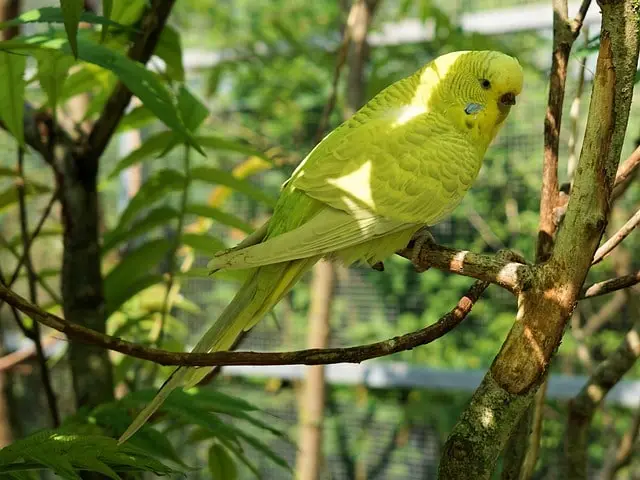
Caiques
Caiques belong to the genus Pionites, which includes four species of parrots. The Yellow-tailed Caiques and the White-bellied Caiques are the two species in this species that are mostly colored yellow.
Both the White Bellied Caiques and yellow-tailed caiques have a white belly, yellow head, nape, vent, thighs, and undertails, while their wings are green.
Caiques are referred to as clown parrots because of their fun-loving and often comical nature. They perform various funny antics in their cages on the ground and are most famous for their signature hopping. Besides being a comedian, caiques are adorable little parrots who like to be petted and cuddled.
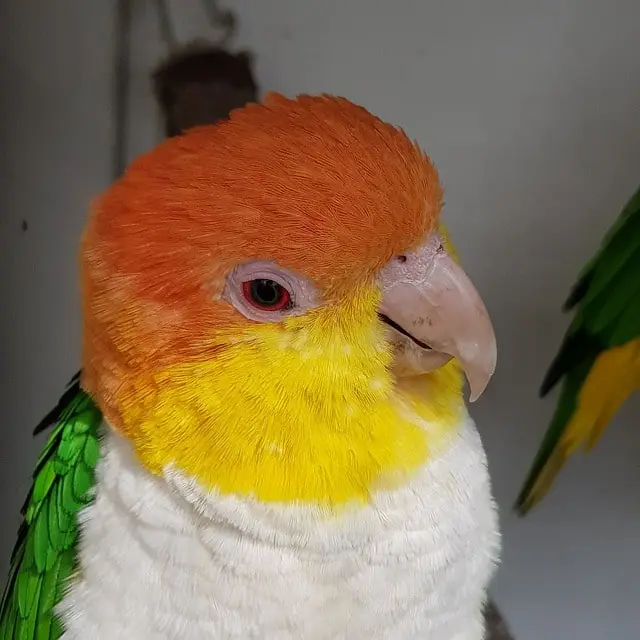
Lutino Cockatiel
Lutino cockatiels are a popular color mutation that is found in captivity. They have a yellow head with white or light yellow plumage and distinctive orange cheek patches.
Apart from their endearing look, there are many things that make cockatiels a beloved pet. Cockatiels are very gentle and easy-going.
They are said to be less nippy compared to other parrots and are easier to handle. They are also relatively quieter, although they may have their occasional spurts. They can do well in a medium-sized enclosure as long as they are provided with toys and adequate time out of the cage.
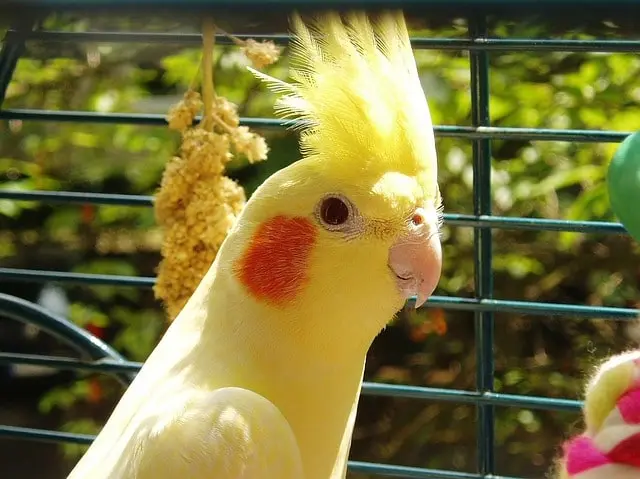
Lutino Quaker Parrot
Quaker parrots are traditionally green, but having been bred in captivity for so long, there have been several color mutations of this species. Lutino cockatiels have light yellow feathers on the front side and a brighter shade of yellow on their backs and wings.
Quaker parrots thrive on social interaction and times become attached to their primary caretaker showing clingy behavior. They do not prefer to hang out by themselves and need constant stimulation. So they are highly demanding in terms of care and socialization.
They also tend to make loud shrieking sounds sometimes and can be quite noisy. That being said, Quakers are amusing birds to have around. They like to seek attention often by performing goofy activities for the entertainment of others and themselves.
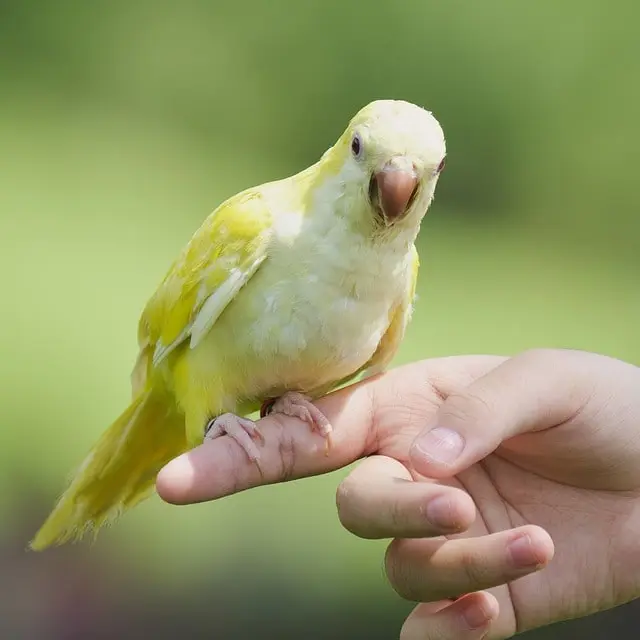
Pacific Parrotlet (Yellow Mutation)
The Pacific parrotlets are the smallest species of parrots native to western Ecuador and northwestern Peru. Pacific parrotlets come in various colors, including yellow. The lutino parrotlet has an entirely yellow plumage, although the shades of yellow can range from light to bright and fiery.
Pacific parrotlets are great apartment birds as they vocalize much less frequently and are not very loud. They are small bundles of joy always bubbling with enthusiasm and ready for playtime.
Indian Ringneck Parakeet (Yellow Mutation)
The Indian ringneck parakeet is an Asiatic parrot species native to Africa and South Asia. Apart from their stock tropical green, Indian ringnecks come in various colors. It is part of what makes them so popular as pet parrots.
The yellow mutation is known as lutino ringnecks. They have an entirely yellow plumage with a red beak. Indian ringnecks are sweet and loving parrots, although they may not start out as so.
These birds are initially quite skittish and go through a bluffing phase when they are young, which can be discouraging for new owners. But once the trust is built between them and the owner, these parrots are a world of fun.
They have excellent talking skills and clarity of voice that rivals even some of the larger parrot species. They can amass a great vocabulary and are quite chatty throughout the day.

Lovebirds
There are several mutations of the lovebirds that are colored yellow. Lutino lovebirds and Lutino Fischer’s lovebirds are the most common yellow mutation of this species. Lutino lovebirds come from the mutation of peach-faced lovebirds. They are bright yellow with an orange head and red eyes.
As pets, they are identical to the common lovebird. They are calm and affectionate and known to bond deeply with their owners. They are one of the smaller parrot species so space is not an issue for them. However, they are inquisitive and active birds that need stimulation from their owners.
